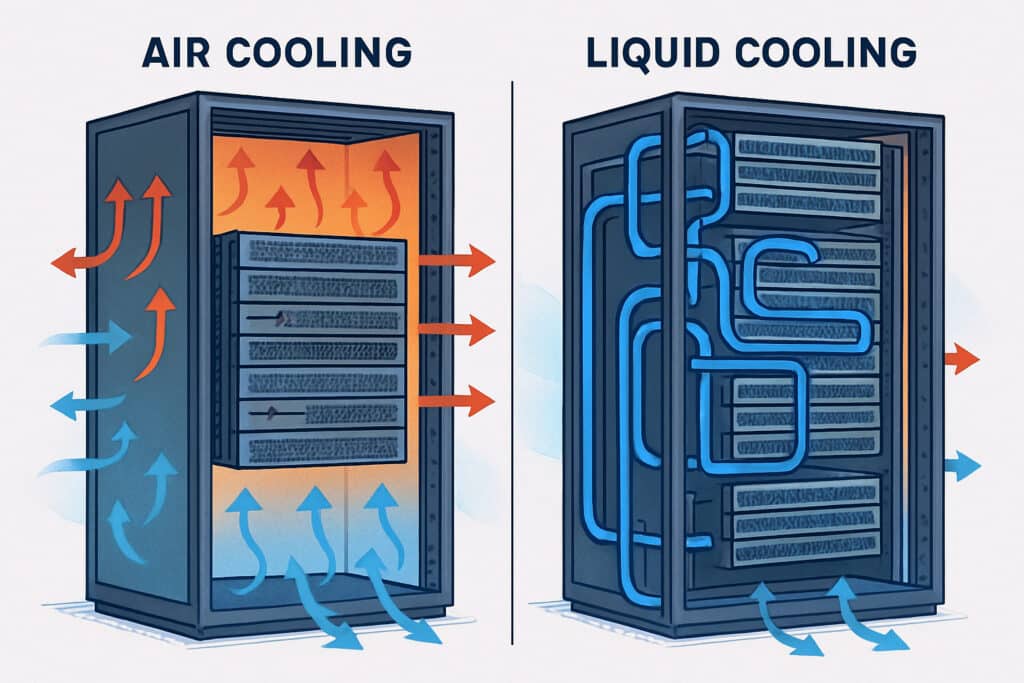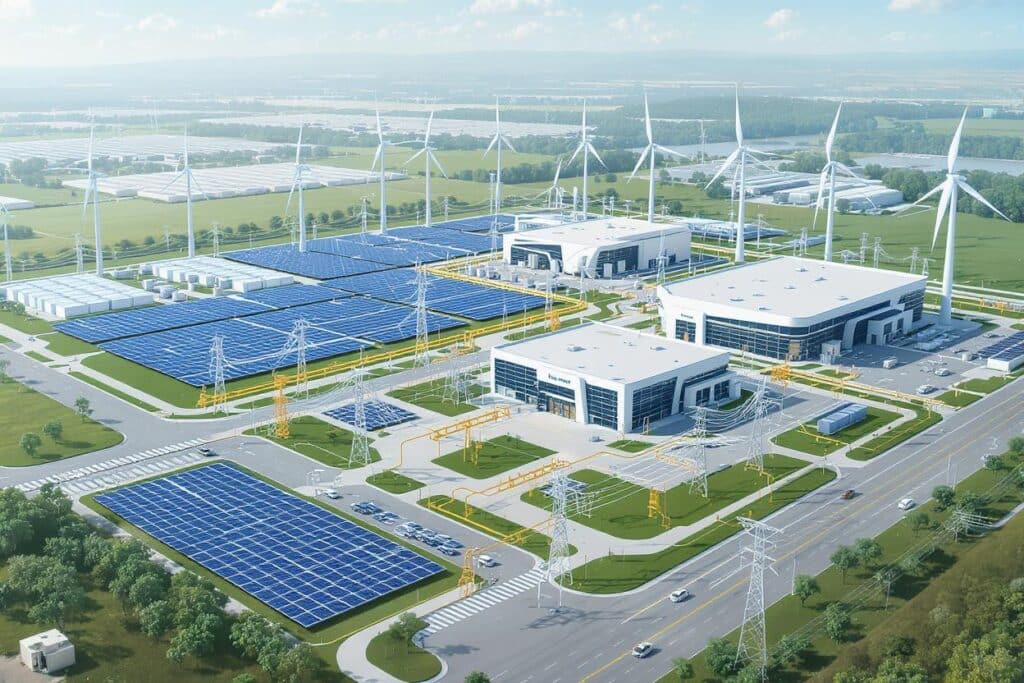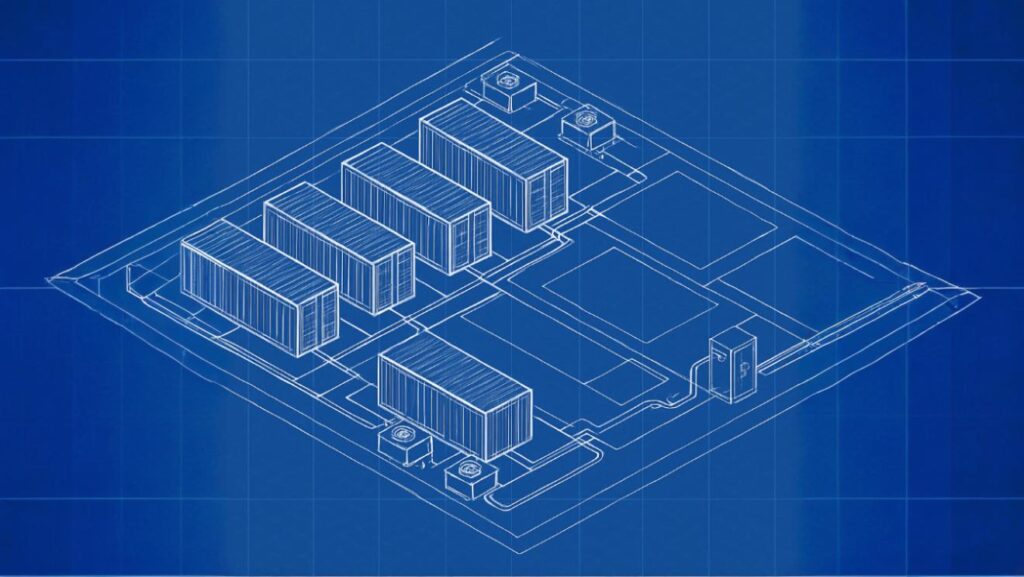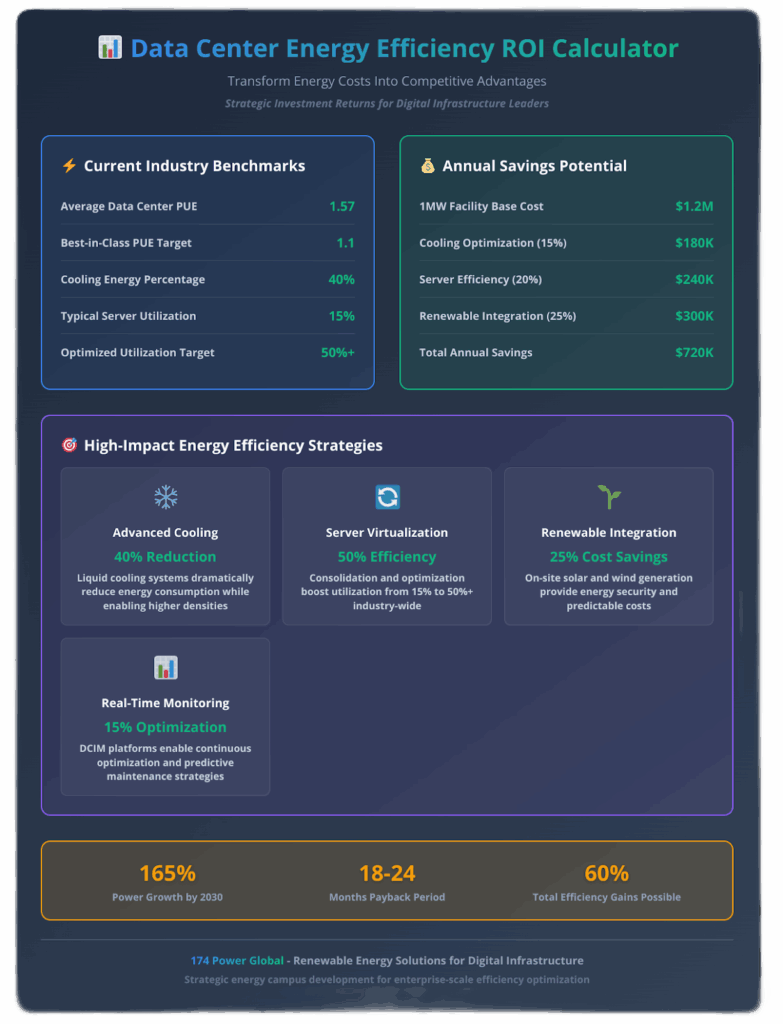BOTTOM LINE: Enterprise data centers can reduce energy costs by 30-40% while meeting sustainability goals through strategic technology deployment and energy campus integration.
- Advanced cooling optimization delivers fastest ROI with up to 40% energy reduction
- Real-time monitoring systems enable 15-20% efficiency gains through automated optimization
- Renewable energy integration addresses compliance requirements while providing grid independence
- Modular infrastructure design allows precise capacity matching without overprovisioning
- Energy storage solutions bridge renewable generation with 24/7 operational requirements
Enterprise IT leaders are facing a perfect storm: AI workloads demanding exponentially more power, utility grids hitting capacity limits, and sustainability mandates requiring immediate action. The International Energy Agency projects that global data center electricity demand will more than double by 2030, with AI driving much of this unprecedented growth. While traditional efficiency approaches have plateaued, forward-thinking organizations are discovering that 174 Power Global’s data center energy efficiency best practices can transform these challenges into competitive advantages through comprehensive energy strategies.
Why Are Data Center Energy Efficiency Best Practices Critical Right Now?
The digital infrastructure landscape has reached an inflection point where energy efficiency determines competitive advantage. US data center energy consumption doubled from 2017 to 2023, jumping from 58 TWh to 176 TWh annually. This surge isn’t slowing down. AI workloads alone are driving exponential growth in power requirements, with individual AI servers consuming up to four times more electricity than traditional compute equipment.
For digital infrastructure companies, these trends create both challenges and opportunities. Power constraints are now the primary bottleneck for expansion in major markets like Northern Virginia and Silicon Valley. Yet organizations that master data center energy efficiency best practices can secure competitive advantages through reduced operational costs, improved sustainability credentials, and enhanced operational resilience.
The stakes extend beyond cost savings. 174 Power Global’s renewable energy solutions demonstrate how forward-thinking infrastructure providers are transforming energy challenges into strategic assets. Companies that treat energy as an afterthought risk being left behind as power availability becomes increasingly constrained.
What Are the Core Data Center Energy Efficiency Best Practices?
1. Implement Advanced Cooling System Integration
Modern cooling technologies represent the fastest path to efficiency gains. Traditional air cooling systems can account for up to 40% of total facility energy consumption, making this the highest-impact optimization area.
Liquid cooling solutions offer dramatic improvements over legacy systems. Direct-to-chip cooling reduces energy consumption by 40% compared to traditional HVAC while enabling higher compute densities. Immersion cooling takes this further, submerging servers in thermally conductive fluids to achieve even greater efficiency gains.

Airflow management optimization provides immediate returns with minimal capital investment. Hot aisle/cold aisle containment prevents air mixing, reducing cooling system strain. Computational fluid dynamics modeling helps identify airflow bottlenecks and optimize equipment placement for maximum thermal efficiency.
2. Deploy Real-Time Energy Monitoring Systems
Visibility drives optimization. Data center infrastructure management (DCIM) platforms provide real-time insights into power usage effectiveness (PUE), cooling efficiency, and equipment utilization patterns. These systems typically deliver 10-15% efficiency improvements by coordinating IT and facility operations.
Advanced monitoring extends beyond basic metrics. Machine learning algorithms establish baseline performance patterns and flag anomalies that indicate developing inefficiencies. Thermal imaging and environmental sensors provide granular data on hot spots and cooling effectiveness.
Continuous benchmarking against industry standards helps identify optimization opportunities. The Department of Energy recommends targeting PUE values below 1.4 for new facilities, with leading operators achieving 1.1 or better through comprehensive monitoring and optimization.
3. Optimize Server Virtualization and Consolidation
Traditional data centers often run servers at just 10-15% utilization rates, representing massive efficiency opportunities. Virtualization and consolidation strategies can improve utilization to 50% or higher while reducing facility requirements.
Containerization provides lightweight virtualization that uses fewer resources than traditional virtual machines. Kubernetes and similar orchestration platforms automatically optimize workload placement for maximum efficiency, concentrating work on the most efficient systems.
Workload scheduling adds another optimization layer. Intelligent distribution algorithms can dynamically allocate tasks based on efficiency metrics, potentially powering down underutilized resources during off-peak periods while maintaining service levels.
4. Integrate Renewable Energy Solutions
On-site renewable generation addresses both efficiency and sustainability objectives while providing energy security. Solar installations paired with battery storage can reduce grid electricity consumption and carbon emissions while offering protection against power outages.

Energy solutions for colocation data centers increasingly focus on comprehensive energy campus approaches. These integrated facilities combine renewable generation, storage, and intelligent control systems to maximize efficiency and reliability.
Microgrids represent the next evolution in data center energy strategy. Self-contained energy networks can operate independently when needed, enhancing reliability while maximizing renewable utilization and reducing dependence on constrained grid resources.
5. Implement Modular Infrastructure Design
Modular data center architecture enables precise capacity matching and incremental scaling. Rather than overprovisioning fixed facilities, modular approaches allow operators to add power and cooling capacity as demand grows, avoiding efficiency losses from underutilized infrastructure.
Containerized data centers provide 40% greater energy efficiency than traditional builds according to industry research. Purpose-built modules can be optimized for specific workloads and environmental conditions, improving overall performance while reducing deployment timelines.

The mobility advantage of modular infrastructure enables “follow-the-renewables” strategies where computing resources can be positioned to take advantage of abundant clean energy resources, even in remote locations where traditional construction would be impractical.
6. Establish Comprehensive Energy Storage Strategies
Battery energy storage systems bridge the gap between renewable generation and 24/7 operational requirements. Advanced storage solutions extend beyond basic backup power to provide load balancing, peak shaving, and grid stabilization services.
Energy storage integration requires careful planning around battery technology selection, capacity sizing, and operational modes. Lithium-ion systems offer high round-trip efficiency but require active thermal management. Alternative technologies like flow batteries provide longer duration storage for specialized applications.
Storage systems work most effectively when integrated into broader energy management platforms that can optimize charging and discharging based on renewable generation patterns, electricity pricing, and operational requirements.
How Should Digital Infrastructure Companies Plan Advanced Technology Implementation?
Strategic technology deployment requires careful sequencing and integration planning. The most successful implementations start with foundational monitoring and optimization before adding advanced technologies like liquid cooling or renewable generation.
Begin with comprehensive energy audits to establish baseline performance and identify the highest-impact improvement opportunities. Many facilities can achieve 15-20% efficiency gains through airflow optimization and equipment rightsizing before investing in advanced technologies.
Phase technology deployment to maximize learning and minimize disruption. Pilot advanced cooling technologies in specific zones before facility-wide deployment. This approach allows operators to validate performance and refine procedures while maintaining operational stability.
Partner selection becomes critical for advanced technology implementation. Digital infrastructure providers with deep expertise in both IT infrastructure and energy systems can accelerate deployment while reducing implementation risks.
What Sustainability and Compliance Framework Should Enterprises Adopt?
Regulatory requirements around data center energy efficiency best practices are intensifying globally. The EU’s Energy Efficiency Directive requires facilities above 500 kW to report energy consumption, renewable energy usage, and waste heat utilization starting in 2024.
ESG reporting standards increasingly focus on data center sustainability metrics. Organizations need comprehensive tracking of Scope 1, 2, and 3 emissions along with renewable energy matching methodologies to address concerns like double counting in carbon accounting.
Sustainability certifications like LEED provide structured frameworks for efficiency improvements. These standards guide design and operational decisions while providing third-party validation of environmental performance that supports corporate sustainability goals.
Waste heat recovery represents an underutilized sustainability opportunity. Advanced cooling systems can capture and redirect waste heat for building heating, industrial processes, or district heating systems, improving overall energy utilization.
Which Optimization Methodologies Deliver Results?
Effective energy management requires comprehensive metrics beyond basic PUE measurements. Advanced facilities track cooling efficiency ratios, renewable energy percentages, and equipment-level utilization patterns to identify specific optimization opportunities.
Real-time dashboards provide operational visibility while historical trending identifies long-term efficiency patterns. Automated alerting systems notify operators of performance deviations before they become significant issues, enabling proactive maintenance and optimization.
Benchmarking against industry standards and peer facilities helps validate performance and identify best practices. The Department of Energy’s data center benchmarking resources provide standardized methodologies for performance comparison and goal setting.
Continuous improvement processes ensure efficiency gains are sustained over time. Regular energy audits, equipment optimization, and operator training help maintain peak performance as facilities age and requirements evolve.
How Can Organizations Future-Proof Their Digital Infrastructure Plan?
The next generation of digital infrastructure will be defined by energy-first design principles. Rather than treating power as a commodity input, successful organizations will integrate energy strategy into fundamental infrastructure planning.
AI-driven optimization platforms will become standard for large facilities. These systems can make complex optimization decisions at speeds impossible for human operators, continuously balancing performance, efficiency, and cost objectives across multiple systems simultaneously.
Edge computing deployment will require distributed efficiency strategies. Smaller facilities must achieve efficiency levels previously reserved for hyperscale data centers, driving adoption of advanced technologies like liquid cooling and renewable integration at smaller scales.
Grid integration capabilities will become increasingly valuable. Facilities that can provide grid stabilization services through demand response and energy storage will generate additional revenue streams while supporting broader energy system stability.
Climate resilience planning must incorporate energy security considerations. Extreme weather events and grid instability require robust backup systems and operational flexibility that go beyond traditional approaches to infrastructure redundancy.

Transform Energy Challenges Into Competitive Advantages
Data center energy efficiency best practices represent far more than cost reduction strategies. They’re fundamental capabilities that determine competitive positioning in an increasingly energy-constrained digital economy. Organizations that master these practices will secure sustainable advantages through reduced operational costs, enhanced sustainability credentials, and improved operational resilience.
The path forward requires a comprehensive energy strategy that integrates advanced technologies with operational excellence. Success depends on treating energy as a strategic asset rather than a commodity expense, implementing monitoring and optimization systems that drive continuous improvement, and partnering with providers who understand both digital infrastructure and energy systems.
As the digital economy continues its exponential growth, energy efficiency will increasingly separate industry leaders from followers. The time for incremental improvements has passed. Digital infrastructure companies need comprehensive energy strategies that position them for sustainable growth in an energy-constrained future.
174 Power Global specializes in transforming energy challenges into competitive advantages through comprehensive renewable energy solutions designed specifically for digital infrastructure applications. Ready to future-proof your operations with proven energy efficiency strategies? Contact our team today to discover how we can help optimize your digital infrastructure for peak performance and sustainability.
Frequently Asked Questions
What is the most cost-effective data center energy efficiency improvement? Airflow management optimization typically provides the highest immediate returns with minimal capital investment. Proper hot aisle/cold aisle containment and equipment placement can deliver 10-15% efficiency gains within weeks of implementation.
How do AI workloads impact data center energy efficiency best practices? AI servers consume 3-4x more power than traditional equipment and generate concentrated heat loads that require specialized cooling approaches. Power requirements for AI data centers often necessitate liquid cooling systems and enhanced power distribution infrastructure.
What role does renewable energy play in modern data center efficiency strategies? Renewable energy for data centers addresses both efficiency and sustainability goals while providing energy security. On-site generation paired with storage systems can reduce grid dependence and provide resilience against power outages.How can smaller facilities achieve enterprise-level energy efficiency? Modular and containerized solutions enable smaller facilities to access advanced technologies previously limited to hyperscale deployments. Standardized efficiency modules can deliver enterprise performance at smaller scales while reducing deployment complexity and costs.



